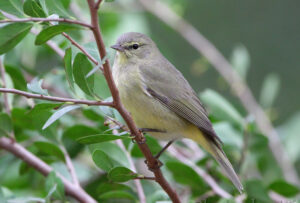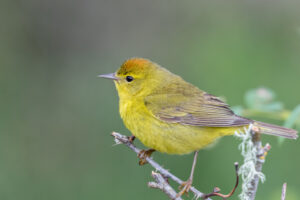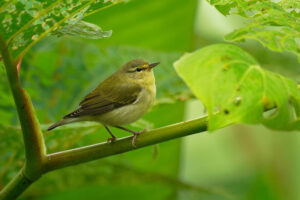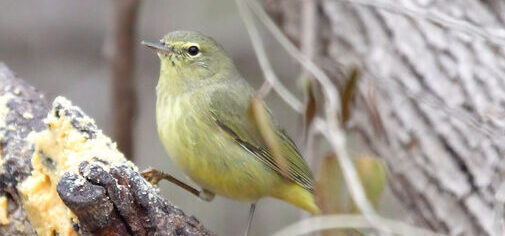Orange-crowned Warbler, Leiothlypis celata
Bill Rowe
It’s mid-October, and the warblers are mostly gone, with a few exceptions: some individual stragglers, the throngs of late-migrating Yellow-rumped Warblers—and the less abundant Orange-crowned Warbler, which peaks in October and may be seen on into November and occasionally the winter. The Orange-crown is modestly colored in subtle blends of gray, green, and yellow, and modest in its behavior as well, quietly exploring weeds, brush, and tree branches, and occasionally peeking out to puzzle a nearby birder who is looking for solid, clear field marks that aren’t quite there. Yet this is a widespread North American bird, more numerous in some other areas than it is here in the Midwest. We see the boreal-forest form that migrates through the eastern half of the country to spend the winter in the southeastern U.S. and Mexico; but other subspecies breed in the mountain west, along the Pacific coast, and even on the Channel Islands off California. Some of these are brighter yellow than ours, and may show the namesake orange crown better; that feature also varies with age and with feather wear, as the orange color is concealed by greenish tips to the crown feathers. The Orange-crown’s “modesty” extends to its song, a simple high trill that drops slightly in pitch in its final notes. If you can pick this one out by song during spring migration, you are doing very well at birding by ear!
IDENTIFICATION: If you see a small bird that is gray-green above without wingbars, it’s likely to be an Orange-crowned Warbler. It should have (1) custard-yellow under the tail (the brightest spot of color on the bird), (2) vague, blurry streaking on the breast and flanks, and (3) an eyering, split by a short dark line through the eye. These features make it an Orange-crown. The main confusion in fall is with the immature Tennessee Warbler, which usually has white under the tail (though occasionally yellow), plain clear yellow on the breast, and a stronger face pattern with longer black eyeline and white eyebrow above it. Tennessees are also brighter green on the back and have a shorter tail than Orange-crowns. Reports of Orange-crowns before late September are usually misidentified Tennessees.
ST. LOUIS STATUS: A regular but uncommon migrant, probably noticed more often in fall, when it runs later than most warblers (see first sentence above). In winter, still rare but occurs more often than it used to, sometimes at feeders.
Learn more and listen to the songs and calls of Orange-crowned Warblers here.



Grayer fall bird: note face pattern, yellow undertail
Photo Credit: Al Smith
Western bird, brighter yellow with crown color showing
Fall Tennessee Warbler for comparison; see Identification




